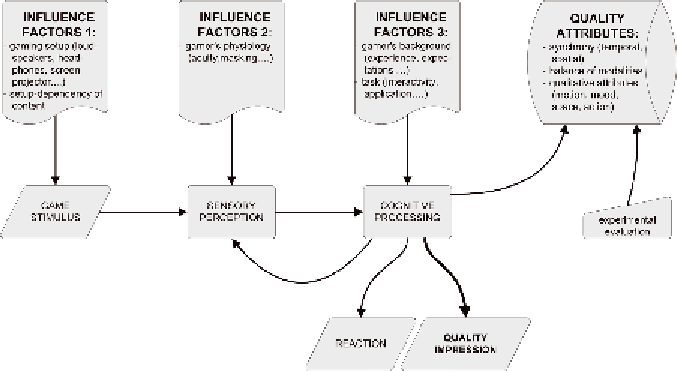Information Technology Reference
In-Depth Information
Figure 2. A salience model for perceived quality in audio-visual games
the Perceptual Cycle. Obviously, the response is
governed by another set of influence factors of
level 3. These span the widest range of factors and
are also the most difficult to quantify: experience,
expectations, and socio-cultural background of the
player; difficulty of task in a specific game situa-
tion; degree of interactivity; and so forth Influence
factors of level 3 are related to the processing and
interpretation of the perceived stimuli.
Cognitive processing will eventually lead to
a certain quality impression that is a function of
all influence factors of types 1-3. This quality
impression cannot be directly quantified. It needs
additional processing to be uttered in the form of
ratings on a quality (or quality impairment) scale,
as semantic descriptors and so on. The overall
quality impression is, in turn, the result of evalu-
ating single or combined quality attributes. For
example, Woszczyk, Bech, and Hansen (1995)
have developed a number of attributes that are
believed to be relevant for an overall audio-visual
quality impression: they organize these attributes
(
quality, magnitude, involvement
,
balance
) into 4
dimensions of perception (
motion, mood, space,
action
), resulting in a 4 by 4 matrix of quality
criteria. Yet, a quantification of their impact is
hardly possible as of now. This is because the
individual attribute's weight not only depends on
the audio-visual game scene under assessment (the
stimuli), but also on the experimental methodol-
ogy itself. An attribute that is explicitly asked for
might be assumed to be of higher importance by
a test player (we know from our experience that
only important things are asked for in any kind
of test). The player's attention will be directed
toward the attribute under assessment, which
distorts unbiased perception of the audio-visual
scene as a whole. Therefore, the player's reaction
in terms of quality rating can be assumed to be
influenced as well.
Experimental results
A number of experiments have shown that player
interaction with an audio-visual game might
have an effect on the perceived overall quality
(Jumisko-Pyykkö, Reiter, and Weigel, 2007; Re-
iter et al., 2007; Reiter & Weitzel, 2007; Reiter
& Jumisko-Pyykkö, 2007; Reiter, 2009). In these
experiments, the general assumption was that by
offering an attractive interactive content, or by
assigning the user a challenging task, this user
would become more involved and thus experience
a subjectively higher overall quality. Along the

Search WWH ::

Custom Search